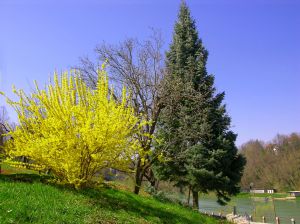There isn’t much a homeowner can do to reduce their risk of loss caused by earthquakes, hurricanes and tornadoes. When it comes to wildfire however, there are several ways homeowners can protect their homes from fire.
Wildfires occur no matter our best efforts and keeping a wildfire away from your home starts with your landscaping. Homeowners may want to talk with their insurance agent or state agricultural college for tips and advice about fire resistant landscaping. In many cases insurance companies will inspect for defensible space and firewise risk management before issuing or renewing a homeowner insurance policy.
 Trees on your property may provide a large amount of available fuel for a fire. Trees that burn can produce radiant heat which may ignite shrubs, and structures. Selecting the best species of tree to plant on your property and properly pruning and caring for your landscaping can reduce the risk of your house being involved in a wildland-urban interface area.
Trees on your property may provide a large amount of available fuel for a fire. Trees that burn can produce radiant heat which may ignite shrubs, and structures. Selecting the best species of tree to plant on your property and properly pruning and caring for your landscaping can reduce the risk of your house being involved in a wildland-urban interface area.
If your property receives enough moisture homeowners are wise to plant deciduous trees such as aspen or narrow-leaf cottonwood. These species, don’t burn well even when planted in dense clumps. The most important issue with deciduous trees is cleaning up the dead leaves in fall.
If your property has moisture levels limit your choices to evergreens, be careful and plan their placement on your property. Don’t plant trees near your house or other structures and be sure to leave room between trees to allow for growth. Tree spacing in the defensible space of your home need to be at least 10 feet between the edges of tree crowns. If planted on steep ground, even more space is needed between tree crowns. Smaller trees may initially be planted with 20- to 25-foot spacing and eventually will need to be thinned to keep the proper spacing.
As trees grow, homeowners need to prune tree branches to a height of 6-10 feet above the ground. Don”t over prune the crowns it’s always wise to avoid removing more than one-third of the live crown when pruning.
Planting, pruning and regular seasonal maintenance is important for homeowners at risk for wildfire. Some other important things to keep in mind are:
- Remove dead or dying trees and shrubs.
- Keep trees and shrubs pruned. Branches of mature trees should be at least 6-10 feet from the ground and shrubs under trees should be no more than 18 inches high.
- Trim branches so they don’t extend over the roof of the house or any out buildings.
- Dispose of cuttings and debris avoid keeping debris piles on your property.
Selecting appropriate tree species, for your area and giving them the care they need, can give homeowners not only beautiful property but also protect their house and possessions. The Arbor Day website can give you information about a variety of firewise tree specifies you may want to consider for your property.
Recommended large hardwood trees:
- Black cherry
- Black gum
- Hackberry
- Honey locust
- Post Oak
- Shumard Oak
- Other Common Oaks
- Pecan
- Sweetgum
- Sycamore
Recommended medium-sized trees:
- Western soapberry
- Common persimmon
- Dogwood
- Eastern redbud
- Fringe tree(Old Mans Beard)
- Hophornbeam
- Magnolia
- Ornamental maples
- Red maple
- Serviceberry
- Apple and crabapples
- Wild plum
Photo credit for this blog entry:  (no use restrictions for this photo)
(no use restrictions for this photo)
![]() Related Blogs:
Related Blogs:
- Is Your Home In The Wildland-Urban Interface?
- Landscaping To Reduce Wild Fire Risks For Homeowners.
- Firewise Landscaping: Trees
- Evacuation Planning
Glossary of Insurance Terms:
A | B | C | D | E | F | G | H | I | J-K | L | M | N | O | P | Q-R | S | T | U-V | W-Z
Families.com Blogs are for informational purposes only. Families.com assumes no responsibility for consumer choices. Consumers are reminded that it is their responsibility to research their choices properly and speak to a certified insurance professional prior to making any decision as important as an insurance purchase.

